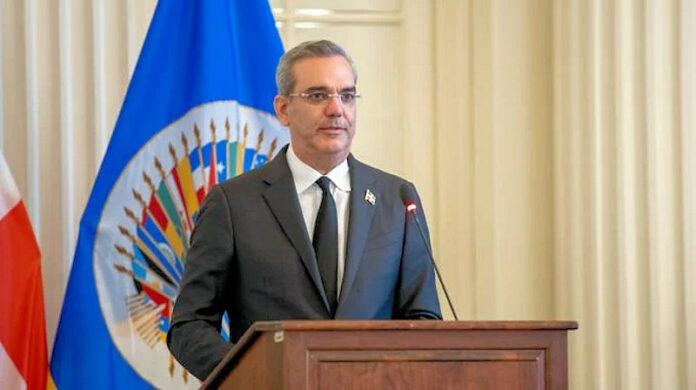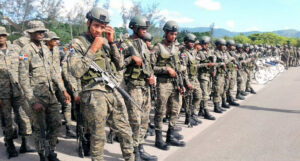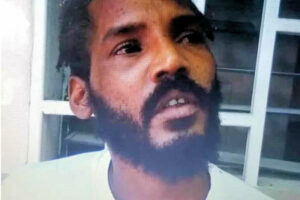
Tensions between Haiti and the Dominican Republic have grown in recent weeks while Dominican nationals are reportedly collaborating with some of Haiti’s most notorious criminal armed groups, particular the kidnappers based in Martissant and Village de Dieu.
Last week, Dominican President Luis Abinader traveled to Washington to meet with U.S. government officials about the situation and to address the Permanent Council of the Organization of American States (OAS) on Thu. Sep. 15.
“The crisis that overflows the borders of Haiti is a threat to the national security of the Dominican Republic”, Abinader told the body. He has been pushing for a renewed foreign military intervention into Haiti over the past several months and plans to build a $30 million border wall along the entire 244-mile frontier with Haiti, although only a small 14-mile section is currently under construction.
Furthermore, the Dominican Army has deployed some 12,000 troops along the border, including special forces and the elite 6th Mountain Rifles Battalion (similar to U. S. Army Rangers). Other forces are equipped with armored halftracks and ATVs mounted with heavy machine guns. Helicopters and Super Tucano aircraft have also been monitoring the border, which is reinforced with the latest surveillance technology, besides regular patrols.

In November 2021, Abinader took the unusual step of suspending automatic yearly renewals for Haitian student visas, purportedly concerned that Haitian armed groups could infiltrate the DR disguised as students.
The increased security measures may help curb Haitians crossing into the DR but do nothing to stop Dominicans from traveling to “el pais vecino,” the “neighboring country,” as they often refer to Haiti.
In June, Diario Libre revealed that Molaï Ortiz Mieses, known as “Nèg a tè,” was a leading member of the Martissant gang headed by “Ti Lapli,” one of Haiti’s most brazen kidnapping kingpins.
According to the Haitian police, Mieses, 32, said that “many Dominicans are an integral part of the armed gangs that currently operate in Haiti.”
He also “allegedly revealed that each gang has Dominican nationals in its ranks” and “other gangs have direct connections with Dominicans,” Diario Libre reported.
The Haitian police also said they had arrested people connected with illegal arms trafficking across the border from the Dominican Republic via the Haitian towns of Belladère and Ouanaminthe, among others.
Gédéon Jean, the executive director of the Center for Analysis and Research on Human Rights (CARDH), also feels that Dominicans are a part of Haitian criminal gangs, according to the press agency EFE.
“Some of the kidnapped say they hear people speaking Spanish in the places where they are held, which makes us think of the Dominicans,” he said. EFE further reported that “other Latin American nationalities are part of the [Haitian] armed gangs,” particularly those of “Ti Lapli” and the “5 Seconds” gang headed by “Izo” in Village de Dieu, another bastion of kidnappers.
The criminal gangs of Ti Lapli, Izo, as well as the 400 Mawozo, which kidnapped 17 North Americans last year, are loosely confederated with others from Belair and Cité Soleil in a front called the “G-Pèp.” Over the past six months, the “G-Pèp” has been at war with the “Revolutionary Forces of the G9 Family and Allies, Mess with One, You Mess with All,” a federation of armed neighborhood organizations fighting crime, the de facto regime of Prime Minister Ariel Henry, and Haiti’s bourgeoisie. Headed by former anti-gang policeman Jimmy “Barbecue” Cherizier, the G9, as it is commonly called, is often conflated by U.S. officials and the mainstream press with the criminal gangs it is fighting against.
Abinader also mixes the criminal and anti-criminal federations, issuing a list last week, published in leading newspapers, prohibiting the entry into the DR of 12 of their leaders, adding as well former Haitian interim Prime Minister and Foreign Minister Claude Joseph.
As if not to be outdone, presidential pre-candidate Francisco Dominguez Brito of the PLD (Partido de la Liberacion Dominicana) recently conducted a sobering press conference in Santo Domingo. Brito, the DR’s former Attorney General under Presidents Fernandez and Medina, publicly called on Abinader to immediately invoke “proactive” measures, such as creating an intelligence database and special unit to counteract Haiti’s armed groups as well as intercepting telephone communications. In short, Brito was recommending that the DR use IMSI Catcher/Stingray equipment, as operated by security agencies in North America and Europe, in order to monitor cellphones and track people believed to be a threat to the state and public safety. This clearly raises many privacy and civil liberty concerns.

Adding to Brito’s dire warnings, former Foreign Minister Miguel Vargas Maldonado publicly declared that insecurity in Haiti represented a “real threat” to the Dominican Republic. He further stated that Haiti’s insecurity situation was worsening rapidly, and the power vacuum placed that nation on the verge of civil war.
Whenever Haiti has the spotlight, Dominican ultra nationalist groups are energized. The “Marcha Patriotica” action on Aug. 6, was organized by the “Instituto Duartiano” and other civic society organizations and personalities. The Aug. 6 nationalist action was both quantitatively and qualitatively superior, to similar activities in the past. Hundreds or perhaps thousands attended the march in Santo Domingo’s Colonial Zone. The hashtag #MarchaPatrioticaRD trended quite heavily, especially on the day of action, and currently there is another such activity planned for Santiago in October.
A tragic incident occurred on the day of the Aug. 6 “Marcha Patriotica,” the hate crime stabbing death of an Afro-Dominican man in Santo Domingo. This hate crime happened on a bus of OMSA (the Metropolitan Bus Authority), following an argument between two passengers “regarding Haitians.” The OMSA Communications Director called the crime an “isolated act,” knowing fully well that earlier on Aug. 6 the anti-Haitian “Marcha Patriotica” had taken place in the capital. The murder happened later that afternoon. Furthermore, OMSA did not immediately release the videos of this hate crime, according to the victim’s family, raising suspicions of evidence tampering and obstructing justice.
The number of Haitians in the Dominican Republic is unclear, with some saying there are about half a million, by UN counts, to as many as one million or more, according to other references. Recent statistics indicate, that sometimes as many as 7,000 forced repatriations of Haitians per month or more occur from Dominican territory.
The ultimate responsibility for what is transpiring in Haiti right now falls squarely on the United States, which has interfered in Haiti’s internal affairs for over a century.
“The island is one and indivisible,” Toussaint L’Ouverture prophetically pronounced over two centuries ago. Undoubtedly, the fates of both peoples of Hispaniola are inextricably intertwined in this tumultuous 21st century.
Ariel Fornari is an independent journalist based in the Dominican Republic.










Obviously “The island is one and physically indivisible”, but with two totally different countries divided by a border
[…] 25,000 troops at some undetermined but imminent period in the future.” The Dominican Republic has stationed troops at its border with Haiti and calls for international military […]
[…] 25,000 troops at some undetermined but imminent period in the future.” The Dominican Republic has stationed troops at its border with Haiti and also is calling for foreign military intervention into […]